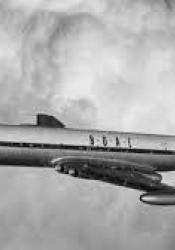Commercial Airlines
In Margot Livesey’s retelling of Charlotte Bronte’s Jane Eyre, the flight of Gemma Hardy, Livesey creates several binary’s using flight from juxtaposing natural elements like birds to manufactured elements like aircrafts as juxtaposing the idea of running away or heading towards something. Livesey’s use of creating a binary out of flight is explicit when Gemma takeoffs to Iceland to find her family. Livesey writes, “Since childhood, I had waved whenever I saw a plane pass over-head[...] I had witnesses half-a-dozen of the huge machines rush down the runway and rise into the sky[...] My plane hurtled over the tarmac it seemed impossible that even the most vigorous engine could lift all these people” (405). In this passage, the reader is met with Gemma's flight's internal and external journey. It can be difficult for the reader to discern whether Gemma is running away from Archie or heading towards her family. When this passage is put in context within the time period and advanced technological breakthroughs of the early 1960s, it is clear that Gemma is not running away but is moving in a more positive direction.
This history of aviation goes as far back as the fifth century with the creation of kites in China, but the earliest designs for man-powered flight has its roots in the fifteenth century with Leonardo Da Vinci (History of Aviation for Aviation History Month: Spartan College). However, it wouldn’t be until 1903, when the Wright brothers successfully flew, that man would achieve flight and start the modern aviation period (Bilstein). In 1914, airplanes were still far away from their modern-day jet plans, but the United States would see the first commercial airline in that year, the initial feedback from customers where the planes were too loud (History of Aviation for Aviation History Month: Spartan College). World War I would spur on the golden age of aviation, with rapid improvements to the advancements of air travel. During the interwar period (1918-1939), aviation would see some prominent figures emerge like Charles Lindbergh and Amelia Earhart, who would gain renown for achievements in aviation (Bilstein). During this time, commercial airlines like Pan am, and TWA airlines began to crop, modeling their airplanes after luxury cruise ships. The first airlines were costly, and typically only the wealthy would fly (Watson).
At the start of World War II, aviation would continue to evolve but much slower. For example, developments for the Jet engine were delayed in the 1940s to focus on making improvements to propeller-based warplanes (Watson). It wouldn’t be till 1952 when the world saw its first commercial jet plane, the British De-Havilland DH 106 Comet. Its jet engine and pressurized cabin significantly reduced the noise while traveling, driving up the demand for travel. The plane suffered from several issues and was surpassed by a newer model, the Comet 4, and other commercial jet planes like the Boeing 707-121, which could hold 189 passengers (Watson). These planes would then kick off the Jet age in the early 1960s, with airline companies worldwide trying to increase both the size and speed of their aircraft to keep up with demand. As a result, the jet age would yield what we consider to be the modern-day airplane (Bilstein).
When looking back to Gemma Hardy, the lens of aviation history helps explain much of Gemma’s astonishment while flying Iceland, as she was doing something very few people had done. Given the rapid advancements from the original airplane in 1903 to the modern airplane in the early 1960s, the ability to fly was seen as a pinnacle of human achievement well through the twentieth century. In addition, because flight represented human achievement, much like how the flight was considered a step forward for technology, Gemma flying can be seen as a step forward for women’s independence, as her choice to fly is predicated on her agency and free from the influence of either Archie or Sinclair.
Work Cited
Bilstein, Roger E. “The Aeronautical Infrastructure.” Encyclopædia Britannica, Encyclopædia Britannica, Inc., https://www.britannica.com/technology/history-of-flight/The-aeronautical-infrastructure.
“De Havilland Comet 3 & 4.” BAE Systems | International, https://www.baesystems.com/en/heritage/de-havilland-comet-3---4.
“History of Aviation for Aviation History Month: Spartan College.” Spartan College of Aeronautics and Technology, 26 Oct. 2021, https://www.spartan.edu/news/history-of-aviation/.
Livesey, Margot. Flight of Gemma Hardy - A Novel. Harpercollins Publishers Inc, 2012.
Watson, Stephanie. “Science and Its Times: Understanding the Social Significance of Scientific Discovery”. Encyclopedia.com. 24 Jan. 2022 .” Encyclopedia.com, Encyclopedia.com, 27 Feb. 2022, https://www.encyclopedia.com/science/encyclopedias-almanacs-transcripts-....

